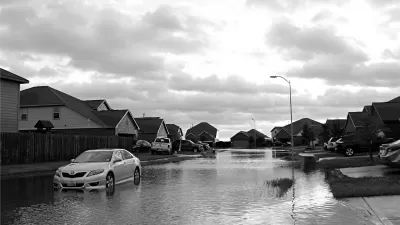Vigorous continued demand for Houston homes left some realtors surprised after the city endured catastrophic flooding. For a lot of new construction, elevated homes may become the norm.

Houston has long symbolized the Sun Belt's magic brew of abundant housing and plentiful jobs. Annie Correal and Conor Dougherty write, "The Houston metropolitan area grows by about 400 people a day and builds 40,000 housing units a year, making it the nation's largest new-housing market, with 7 percent of residential construction. With light regulation and a civic model tied to growth, it has kept housing prices low by building everywhere and anywhere, and fast."
All of that got thrown into question when Harvey did its damage. But now there seems to be little doubt that Houston's bumper housing market will live on. "But as insurance and government money comes in, developers and real estate agents are betting that the area will quickly clear the backlog and continue along its normal trajectory of adding homes and people."
In the short term, undamaged homes may be at a premium. "At the same time, many economists are forecasting that the price of undamaged homes will rise as demand outstrips supply. Early estimates suggest that tens of thousands of homes were damaged, and developers are worried about labor shortages as repairs get priority over new construction."
As you'd expect, elevated homes fared better in the floods. They may become the new normal as flood insurers make elevation a requirement to head off future storms.
FULL STORY: Houston’s Unsinkable Housing Market Undaunted by Storm

Trump Administration Could Effectively End Housing Voucher Program
Federal officials are eyeing major cuts to the Section 8 program that helps millions of low-income households pay rent.

Planetizen Federal Action Tracker
A weekly monitor of how Trump’s orders and actions are impacting planners and planning in America.

Ken Jennings Launches Transit Web Series
The Jeopardy champ wants you to ride public transit.

Washington Legislature Passes Rent Increase Cap
A bill that caps rent increases at 7 percent plus inflation is headed to the governor’s desk.

From Planning to Action: How LA County Is Rethinking Climate Resilience
Chief Sustainability Officer Rita Kampalath outlines the County’s shift from planning to implementation in its climate resilience efforts, emphasizing cross-departmental coordination, updated recovery strategies, and the need for flexible funding.

New Mexico Aging Department Commits to Helping Seniors Age ‘In Place’ and ‘Autonomously’ in New Draft Plan
As New Mexico’s population of seniors continues to grow, the state’s aging department is proposing expanded initiatives to help seniors maintain their autonomy while also supporting family caregivers.
Urban Design for Planners 1: Software Tools
This six-course series explores essential urban design concepts using open source software and equips planners with the tools they need to participate fully in the urban design process.
Planning for Universal Design
Learn the tools for implementing Universal Design in planning regulations.
Heyer Gruel & Associates PA
Ada County Highway District
Institute for Housing and Urban Development Studies (IHS)
City of Grandview
Harvard GSD Executive Education
Toledo-Lucas County Plan Commissions
Salt Lake City
NYU Wagner Graduate School of Public Service





























